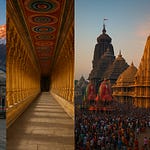Khatushyam Ji, revered as “Sheesh Ke Daani” (the one who gave his head), is a powerful deity worshipped across India, especially in Rajasthan, Haryana, and Gujarat. Known as the Kaliyug ka Deva, he is believed to fulfill the wishes of his devotees and answer prayers with unwavering compassion. The central place of worship is the Khatushyam Ji Temple in Khatu town, Sikar district, Rajasthan, which attracts lakhs of devotees every year.
Origin and Mythological Story
Khatushyam Ji is the Kaliyug incarnation of Barbarik, the grandson of Bhima (one of the Pandavas) and son of Ghatotkacha. A mighty warrior from a young age, Barbarik was blessed with three infallible arrows (Teen Baan), gifted by Lord Shiva and Kamakhya Devi, that could win any war for him.
Before the Mahabharata war, he promised his mother that he would support the weaker side in the battle. Upon hearing this, Lord Krishna, understanding the consequences, appeared as a Brahmin and challenged Barbarik. Realizing Barbarik’s potential and the danger of imbalance, Krishna asked for his head in charity.
Barbarik willingly offered his head, gaining the name “Sheesh Daani” and was blessed by Krishna to be worshipped in Kaliyuga as Shyam, another name of Krishna himself.
Historical Significance
The Khatushyam Ji temple is believed to be constructed around the 11th century, with major renovations and expansion in 1720 AD under the patronage of Roop Singh Chauhan and his wife Narmada Kanwar.
The head (Sheesh) of Barbarik was found buried in the village of Khatu and was enshrined in the temple as Khatushyam Ji, marking it as the primary pilgrimage center.
Architectural Insights
The temple is constructed in white Makrana marble, with ornate silver doors and beautifully painted mythological frescoes. Key architectural features include:
Shyam Kund: Sacred pond where the head was found.
Garbhagriha: Inner sanctum housing the idol.
Jagmohan: Prayer hall decorated with intricate floral designs.
Silver-plated sanctum doors and gold finial atop the temple add to the grandeur.
Religious Significance
Khatushyam Ji is considered the God of Kaliyug, fulfilling the desires of true devotees.
Devotees believe that sincere darshan and surrender to Khatushyam removes obstacles, sins, and sorrows.
He is worshipped as Shyam Baba, representing courage, sacrifice, humility, and divine strength.
Rituals, Puja & Aarti
Daily rituals include:
Mangala Aarti (early morning)
Shringar Aarti (decoration)
Bhog Aarti (food offering)
Sandhya Aarti (evening prayer)
Shayan Aarti (nighttime)
Special charanamrit (holy water) is offered, and sindoor (vermilion) from his forehead is considered highly sacred.
Temple Timings
Summer: 4:30 AM to 12:30 PM and 4:00 PM to 10:00 PM
Winter: 5:30 AM to 1:00 PM and 4:30 PM to 9:00 PM
Mangala Aarti: Between 4:30–5:30 AM (depending on season)
Major Festivals and Tirth Events
Phalgun Mela (February–March): Largest festival with lakhs of pilgrims.
Janmashtami: Celebrated as Krishna and Shyam share a divine bond.
Ekadashi, Dwadashi, and Poornima: Regular peak days for pilgrims.
Shyam Navami: Celebrates the day of his head donation.
Gyaras: A monthly festival celebrated with grandeur.
Devotee Practices & Beliefs
Devotees chant “Hare Ka Sahara – Baba Shyam Hamara.”
Pilgrims often travel on foot (Pad Yatra) to the temple from nearby towns and states.
Coconut, churma, and sweet offerings are made.
Many tie threads at the temple with vows or wishes.
Mystery & Spiritual Insights
Barbarik’s head was alive even after the sacrifice, witnessing the entire Mahabharata war.
Krishna declared his sacrifice greater than the war itself.
The Shyam Kund is believed to have healing powers.
Shlok / Mantra
A popular Shyam Ji shlok:
"Shyam Teri Bansi Pukare Radha Naam,
Log Karey Meera Ko Deewana."
And his powerful mantra:
“Om Shri Shyam Devaya Namah”
Best Time to Visit
Phalgun (Feb–March) is the peak season due to the annual Mela.
Avoid high summers (April–June) due to Rajasthan’s heat.
October to March is considered ideal for pleasant weather and darshan.
What to Do at Khatushyam Ji
Take a dip in the Shyam Kund.
Attend Mangala Aarti at dawn.
Offer coconut, flowers, chadar (cloth), and prasad.
Visit Roop Niwas Garden and Gourishankar Temple nearby.
Participate in bhajan sandhya and community singing.
Shop for religious items, chadar, and souvenirs in the temple bazaar.
How to Reach
By Road: Khatu is 80 km from Jaipur and 55 km from Sikar.
By Train: Nearest station – Ringas Junction (17 km), connected to major cities.
By Air: Nearest airport – Jaipur International Airport (90 km).
Accommodation
Plenty of dharmshalas, budget hotels, and trust-run lodges are available for pilgrims with food and basic facilities. Book in advance during festivals.
Khatushyam Ji stands as a symbol of devotion, sacrifice, and surrender. His temple is not just a place of worship, but a center of spiritual awakening. For millions, faith in Shyam Baba is a guiding light through life’s darkest phases.
"Jo aaye Shyam ke dwar, na rahe koi lachar."
(Whoever comes to Shyam's door, never remains helpless.)










